On weekends, you can often find me at the local airport, photographing planes as they come in to land. Military, civilian, commercial – there’s something beautiful about these hulking beasts moving through the sky. Human and machine coming together to perform unbelievable feats.
My love of photography and aviation have always blended together seamlessly. Aviation photography is an unusual subject, which is great for your portfolio. It also broadens your photographic skills across a range of subjects from abstract to documentary.
And it gets you out of your comfort zone! This post will make that jump into the unknown a little easier. It will provide you with all you need to know to get started with aviation photography.

Aviation Photography: Before You Get to the Planes
Your Kit
Just as with aviation itself, one of the golden rules of aviation photography is to come prepared.
If you plan to be out in the sun, pack some sunscreen and a hat. Making a day of? Pack a tasty picnic. Wear comfortable shoes, especially at airshows. There is a lot of walking around in aviation photography.
Binoculars will help you to prepare for a shot in advance. Some aircraft will zip by, leaving only a one or two second window for photo opportunities.
You could even pack a camping chair! Be sure to take additional camera batteries if possible and memory cards too.

Camera and Lens
You’ll often see a thick row of photographers armed with telephoto lenses at the front line of an airshow. Depending on the airshow, aircraft performing in a display will be out of the reach of a generic zoom lens.
But telephoto lenses are expensive, and heavy. If, like me, you can’t get your hands on a telephoto lens, there are still plenty of creative options. In fact, when it comes to aviation photography, it can all be about creativity.
I shoot with my old faithful, a Canon EF 24-105mm lens. It has quite a good reach and makes for a great general purposes lens. Additionally, it’s relatively light. This is ideal for trekking around airshows all day long.
Choose the lens you are most comfortable with. If you can’t photograph an aircraft from greater distances, there are plenty of ways to make up for it. And we’ll get to those a little later.
Unless you want to photograph a time-lapse image at an airport, there isn’t much opportunity to use a tripod.
Keep moving! Photograph different angles and perspectives. This is especially the case at airshows, where you can get up close and personal with the aircraft.
ExpertPhotography recommends: Canon EF 24-105mm
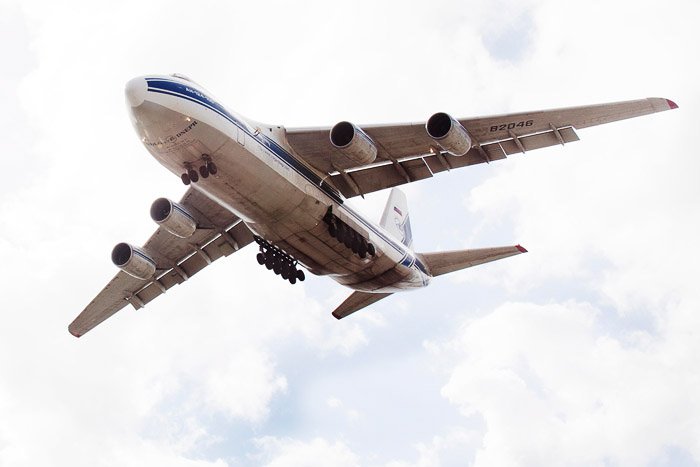
Tracking Apps
To get the best pictures, you can monitor incoming air traffic with apps like Flightradar. You can also check flight listings online.
There are sometimes live-feeds of aviation communications online, but be careful not to use up a lot of data. Try to connect to Wi-Fi whenever possible.

Airport Security
The times when a person passionate about aviation could have a quick look around a hangar are gone. Pilots and maintenance crew no longer just invite people in for a chat.
Security has increased in the meantime and it’s a good idea to know where you can and can’t be at a given airport. Don’t trespass on off-limit locations (usually indicated with signage) and be sure to keep your photo ID with you.
In my experience, I’ve been able to park under the flight-path with no issues. More often than not, security have approached me out of curiosity rather than concern. But this is not true for every airport. Cooperate with security, and you’ll be fine.

The First Step
Once you’ve got your kit sorted, getting started with aviation photography is simple. Grab your camera and head out to an airport or airshow.
The majority of aircraft at airports are commercial planes or light aircraft whereas airshows have more unusual planes on display. Moreover, for larger airports there can be areas dedicated to plane spotting.
Having a Google of your local airport will usually indicate where to find a good spot. Make sure to also check wind direction. It can influence where aircraft take off and land from on a runway.
When it comes to airports, I prefer to take photos of aircraft landing but you may want to shoot side-on or at a steeper trajectory on take-off too. It’s up to you.


Airshows – Working at Your Level
This might surprise people but you don’t need a giant lens to be a great aviation photographer.
Seek out moments when aircraft are flying lower than usual, like take-off or landing at airports. Position yourself beneath or slightly to the side of flight paths and make use of designated plane spotting sites.
At airshows, take advantage of ‘low and slow’ passes often performed so the audience can get a good look at an aircraft in flight.

Another thing to remember is that aviation photography isn’t confined to photographing aircraft in the air!
In fact, much of my aviation photography is made up of aircraft on the ground. Like that, I can focus on the more subtle qualities of aircraft.
Many people don’t get to encounter a plane up close. If you photograph the details of one, it provides a unique insight to a viewer.
Every aircraft is different, so try to hone in on some interesting quirks, shapes, patterns or textures. This way you can create some inspiring abstract photographs. They look especially great in a series.
Taking advantage of your surroundings is another trick to aviation photography. Have a look around and see if you can add some extra detail to an image by using the surrounding environment.
Puddles, puffy clouds, landmarks. All of this can be incorporated into your image to create a more meaningful story.
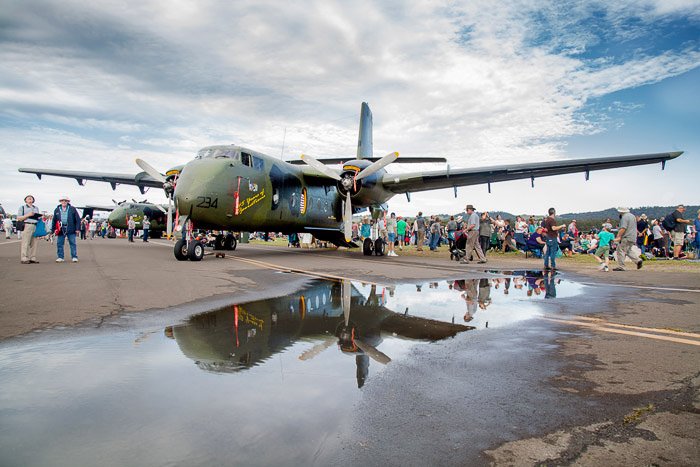
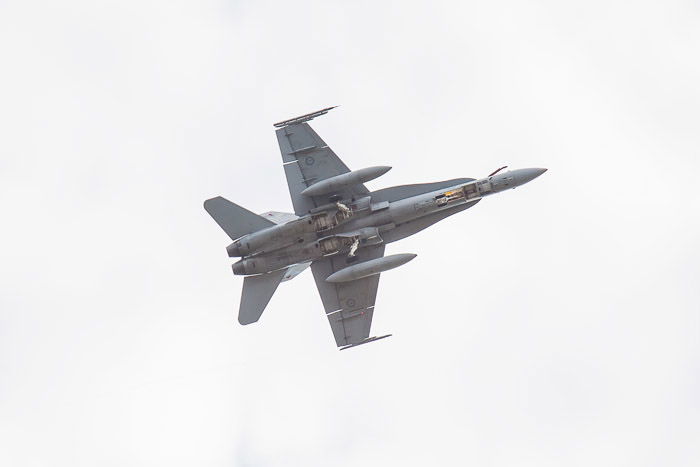

Composition
Line, shape, form, texture, pattern, color and space are the building blocks of photography. And aviation photography is no different.
As I mentioned before, focusing on detail is important in exploring the unusual nature of our flying machines. Close-up photographs of rivets, paint and mechanics can create abstracted images. Photographs of aircraft from a distance can emphasize elaborate shape and form.
And don’t limit yourself to only photographing planes either.
The symbiosis between aircraft and people is a fascinating relationship. Try photographing people interacting with aircraft and see if you can create a more dynamic series of images.
Give yourself time to compose images and don’t be afraid to experiment a little.

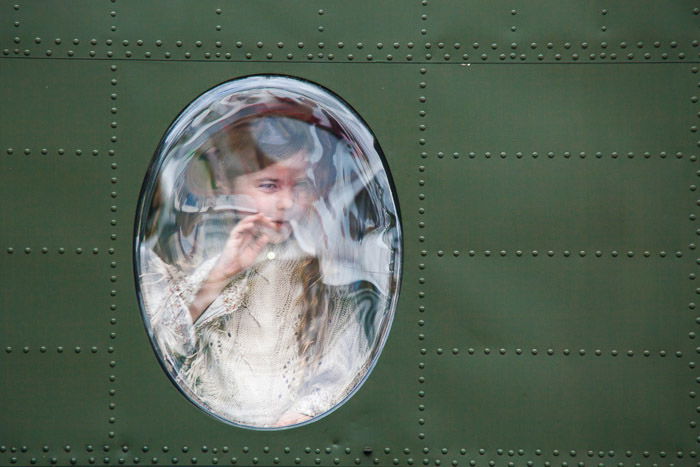
Metering, Shutter Speed and Aperture
Aviation photography can be indoors (like in museums) or outdoors. To make sure you are getting the correct exposure, you will need to accurately measure the varying light levels in a scene.
Center weighted metering is ideal because the exposure is calculated by reading the center of a given image. This means that the center of the image will be prioritized in terms of exposure and deliver a nice, evenly lit scene.
The shutter speed and aperture in aviation photography is rarely different to any other type of photography. Depending on the speed of your subject, which can range from super fast to dauntingly slow, you may want to pan out to create more movement. If so, this requires a slower shutter speed.
To suspend an aircraft in the sky, or one that is just touching down, select a higher shutter speed. Personally, I stick to shutter priority mode so that I can easily switch between a fast and slow exposure.
I also engage continuous shooting, which is the best shutter mode for action photography. Continuous shooting allows you to capture a series of photographs in quick succession by holding the shutter button down.

At an airshow you never quite know what you’re going to see next so having your shutter on quick-draw helps capture that unique shot. For aircraft with propellers, try to avoid very high shutter speeds exceeding 1/1000th of a second. This can result in unnaturally frozen blades. It can make the aircraft look like it’s about to fall out of the sky!
Having said that, aperture is a fantastic tool in aviation photography because aircraft have so many lines you can follow down the frame.
Rely on your creativity to judge the depth of field of stationed aircraft. Moving around your subject can inspire interesting and creative angles. This can be enhanced greatly with a shallow depth of field.
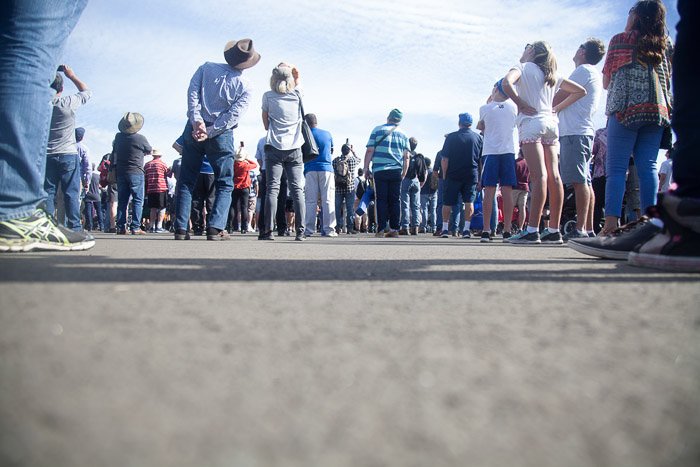
Take a Step Back
Sometimes it’s easy to get caught up in photographing an event. So much so that we can forget to enjoy our surroundings outside the camera frame.
Even if you are concerned about getting that perfect shot, don’t forget to take some time to have a good look around too.
Avoiding photographic tunnel-vision will help you see with fresh eyes, revealing shots you may have missed before. It might also lead to spotting more photographic opportunities.

Conclusion
Aviation is a fascinating subject to work with as a photographer. Just like a camera is an extension of a photographer, the aircraft allows us to achieve amazing feats we couldn’t do on our own.
Just remember to approach aviation photography as you would any other new subject. Take your time, think about composition and remember the golden rule: come prepared!

